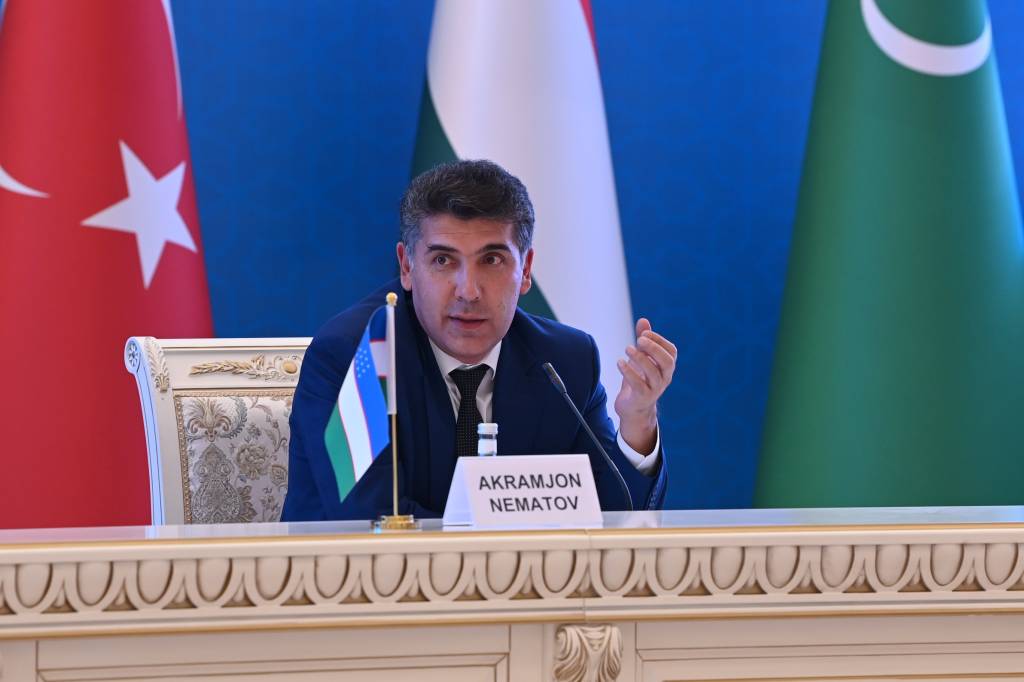
Tashkent hosts the 8th Meeting of the Official Foreign Policy Research Centers of the Member and Observer States of the Organization of Turkic States.
ISRS First Deputy Director Akramjon Nematov moderated and made a presentation at the session on the transport and logistics connectivity of the OTS member countries, innovative technologies and digital services to create a competitive supply chain.
ISRS representative outlined the main factors for strengthening the interaction of the OTS countries in the development of transport infrastructure and the diversification of transport corridors.
First, according to Akramjon Nematov, this is the need for guaranteed access to foreign markets. The pandemic, the crisis in international relations, accompanied by sanctions, trade wars and protectionism, have led to the disruption of traditional transport and logistics links. As a result, the world’s transport and logistics costs in the structure of the cost of goods increased on average from 20% to 50%.
According to the ISRS Deputy Director, this is especially felt by the OTS countries, which is also due to the high share of imports in the structure of our foreign trade. Imports account for more than 40%, that is, about $400 billion, of the total foreign trade turnover of our countries. As a result, prices for food, energy, components and other vital goods have risen significantly. This affects the growth rates of the economies of our countries.
According to Mr. Nematov, this also negatively affects the stability of the economies of the Central Asian countries, which, due to transport isolation, are already experiencing difficulties – transport and logistics costs reach 60% of the cost of imported goods.
Second, he noted that the effectiveness of mutual trade depends on transport connectivity. Today, in the total trade turnover of the OTS countries, which exceeded $970 billion, mutual trade between our states is only $21 billion, or about 3%.
This figure in the European Union exceeds 63.2%, in ASEAN – 70%, in NAFTA – 40.9%, in East Asia – 57.5%.
Central Asia is one of the least connected regions in the world. According to the World Bank, the average level of connectivity in the region, that is, the level of transport access of the states of the region to foreign markets, is no more than 60%, while this figure in the EU and ASEAN countries exceeds 95%. Mutual trade is also limited due to the low level of logistics efficiency.
Third, Akramjon Nematov stated that the need for more active interaction in the field of transport and logistics is explained by the new opportunities that have opened up for the OTS countries to become an important link in the transport and communication connectivity between Asia and Europe and a production and logistics hub.
According to ESCAP, as the expert stated, now the volume of trade between Asia and Europe is 55% of global trade or more than $15.6 trillion. At the same time, land routes account for only 5% of transportation. At the same time, the workload of the Suez Canal, the overcrowding of seaports, and the closure of the northern transit corridors are forcing many countries to look for new routes and reorient transportation to continental routes.
Under these conditions, our macro-region is becoming one of the popular transport corridors, including for the EU countries, where the main role is assigned to the Trans-Caspian corridor.
“At the same time, the capacity of the corridor remains low. The main reasons for this are the underdevelopment of infrastructure, weather conditions, high transport and other costs, the low level of standardization of customs and transit procedures and the lack of transnational digital integration”, he said.
– By developing the Trans-Caspian Corridor, as well as diversifying access to Asian markets through the implementation of such projects as the construction of the China – Kyrgyzstan – Uzbekistan railway and the Trans-Afghan Corridor, we could increase the attractiveness of our region as a transit bridge between Asia and Europe.
“At the same time, we would not only realize the transit potential, but would become an important link in the supply chain linking the regions, especially in an environment where many states rely on the diversification of their foreign economic relations. For this, the Turkic countries have all the prerequisites: we have rich human resources, a mineral resource base, and high industrial growth rates, which average about 16%”, the expert concluded.
The expert meeting, organized by the Institute for Strategic and Regional Studies under the President of the Republic of Uzbekistan, brought together over 60 prominent representatives of the leading think tanks of Azerbaijan, Kazakhstan, Kyrgyzstan, Uzbekistan, Turkey, Hungary, as well as the OTS Secretariat.
UzA








